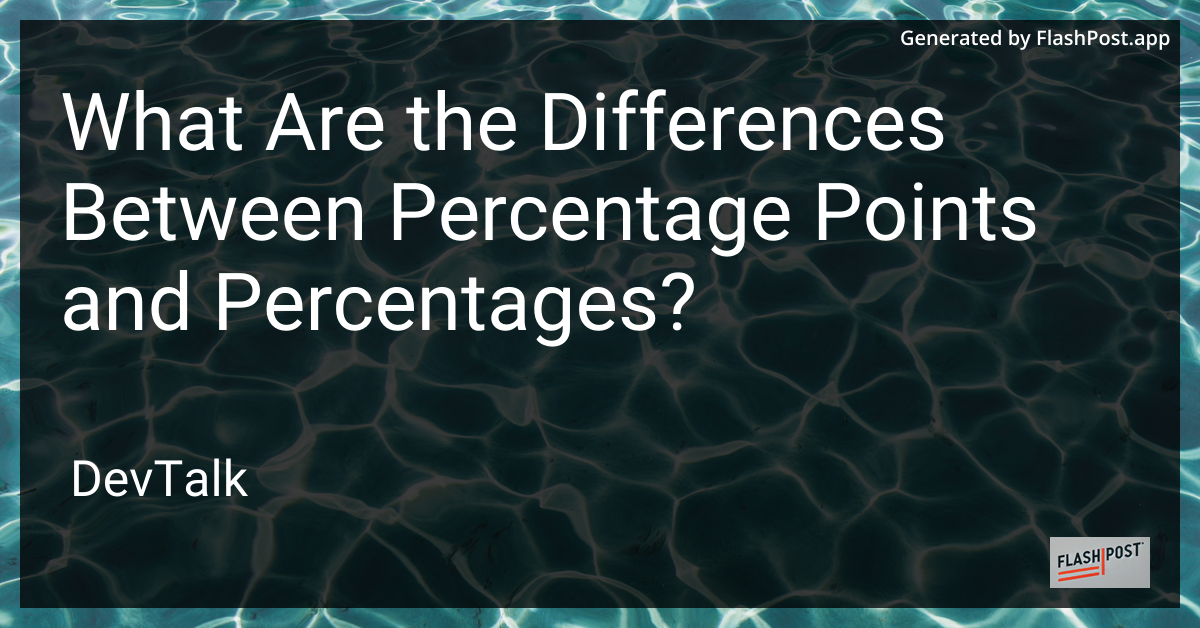What Are the Differences Between Percentage Points and Percentages?

Understanding the Differences Between Percentage Points and Percentages
In everyday conversation, the terms "percentage points" and "percentages" are often used interchangeably.
However, they represent different concepts, especially in fields like statistics, finance, and data analysis. Understanding these differences is crucial for accurately interpreting data, making informed decisions, and communicating effectively.
What is a Percentage?
A percentage is a way of expressing a number as a fraction of 100. It is a dimensionless number often used to express proportions, comparison of quantities, or changes in quantity over time. For example, if you have a group of 200 students, and 50 of them passed an exam, the passing rate in percentage is calculated as:
[ \text{Passing Rate} = \left(\frac{50}{200}\right) \times 100 = 25% ]
Percentages are particularly useful when comparing different value sets or interpreting growth and change rates. They help standardize measurements and provide insights into relative sizes and trends.
What is a Percentage Point?
While percentages are ratios, percentage points are the units used to describe the absolute difference between two percentages. If a percentage increases from 20% to 30%, it is said to have increased by 10 percentage points, not 10%. The distinction is important because an increase of 10% from 20% would be only 22% (10% of 20 is 2, so 20 + 2 = 22).
Comparison Example
Let's illustrate this with a practical example:
-
Assume there is a tax increase proposal where the rate will rise from 5% to 8%.
- Increase in Percentage Points: ( 8% - 5% = 3 ) percentage points
- Percentage Increase:
[ \left(\frac{8% - 5%}{5%}\right) \times 100 = 60% ]
The tax rate increased by 3 percentage points, but this equates to a 60% increase in the tax rate itself.
Importance in Data Analysis
The distinction between percentage points and percentages is particularly relevant in data analysis and statistical research. For accurate data interpretation, analysts must differentiate between absolute changes (percentage points) and relative changes (percentages). This understanding facilitates more accurate evaluations of phenomena such as interest rate adjustments, population growth, and comparison metrics.
For instance, when examining code coverage in software testing or financial reporting metrics, it's crucial to understand whether the discussion refers to absolute differences or growth rates.
- To learn more about code coverage percentage, check out this useful guide.
- For insights on formatting and using percentages in calculations, explore this article on using the absolute function with percentages in Oracle.
- If you're interested in string match percentages using PrestoSQL, visit this discussion.
- Understand how to format numbers as percentages with two decimal places through this informative guide.
By mastering the concept of percentage points and percentages, you can enhance your analytical skills and communicate quantitative data more effectively.
Conclusion
In conclusion, percentages and percentage points are fundamental concepts in numerical data communication. While percentages denote relative changes or parts of a whole, percentage points express absolute differences between values. Understanding and using these concepts correctly is vital in fields like finance, statistics, and data analytics, ensuring accuracy and clarity in data interpretation and reporting.
This article uses markdown formatting and includes informative examples to clarify the differences between percentages and percentage points. It also incorporates links relevant to percentage-related topics in various fields.